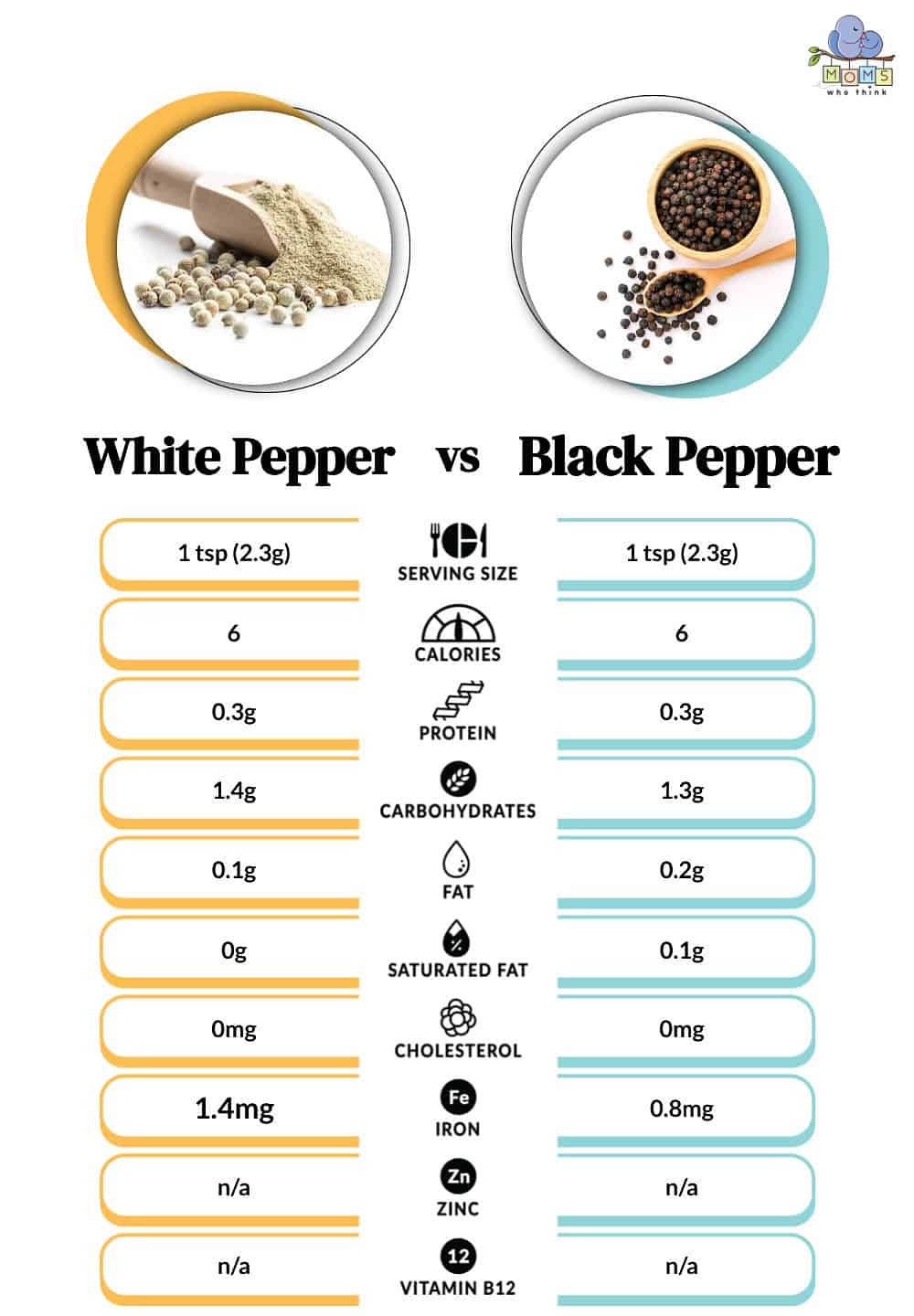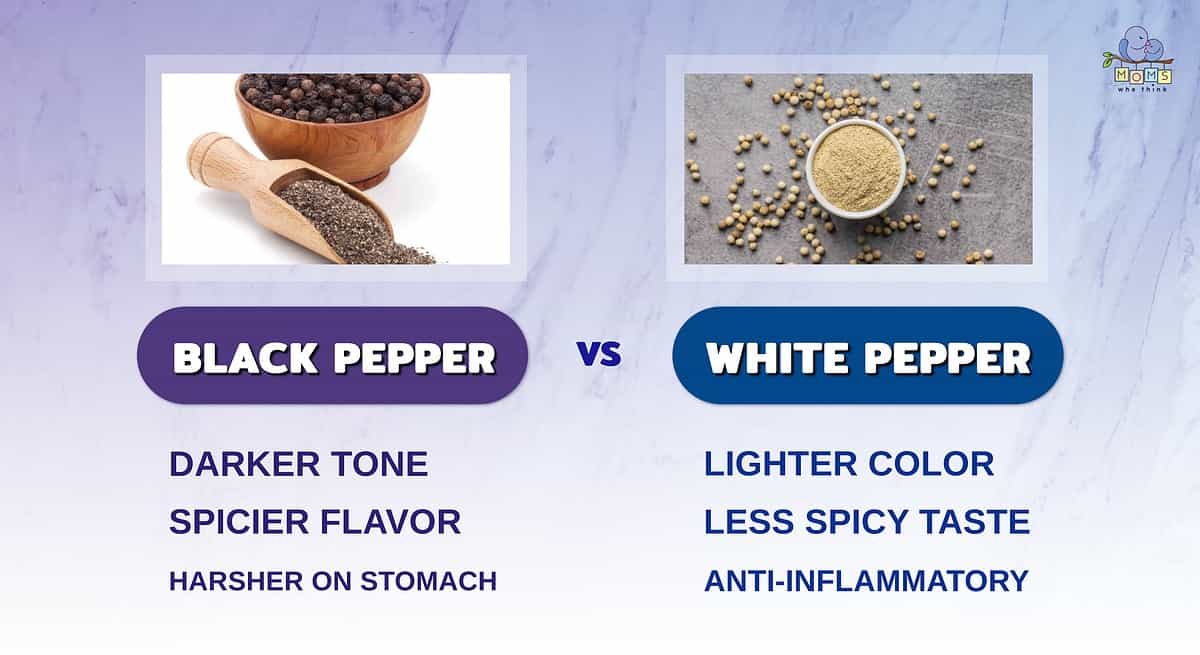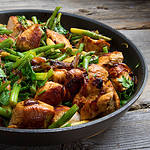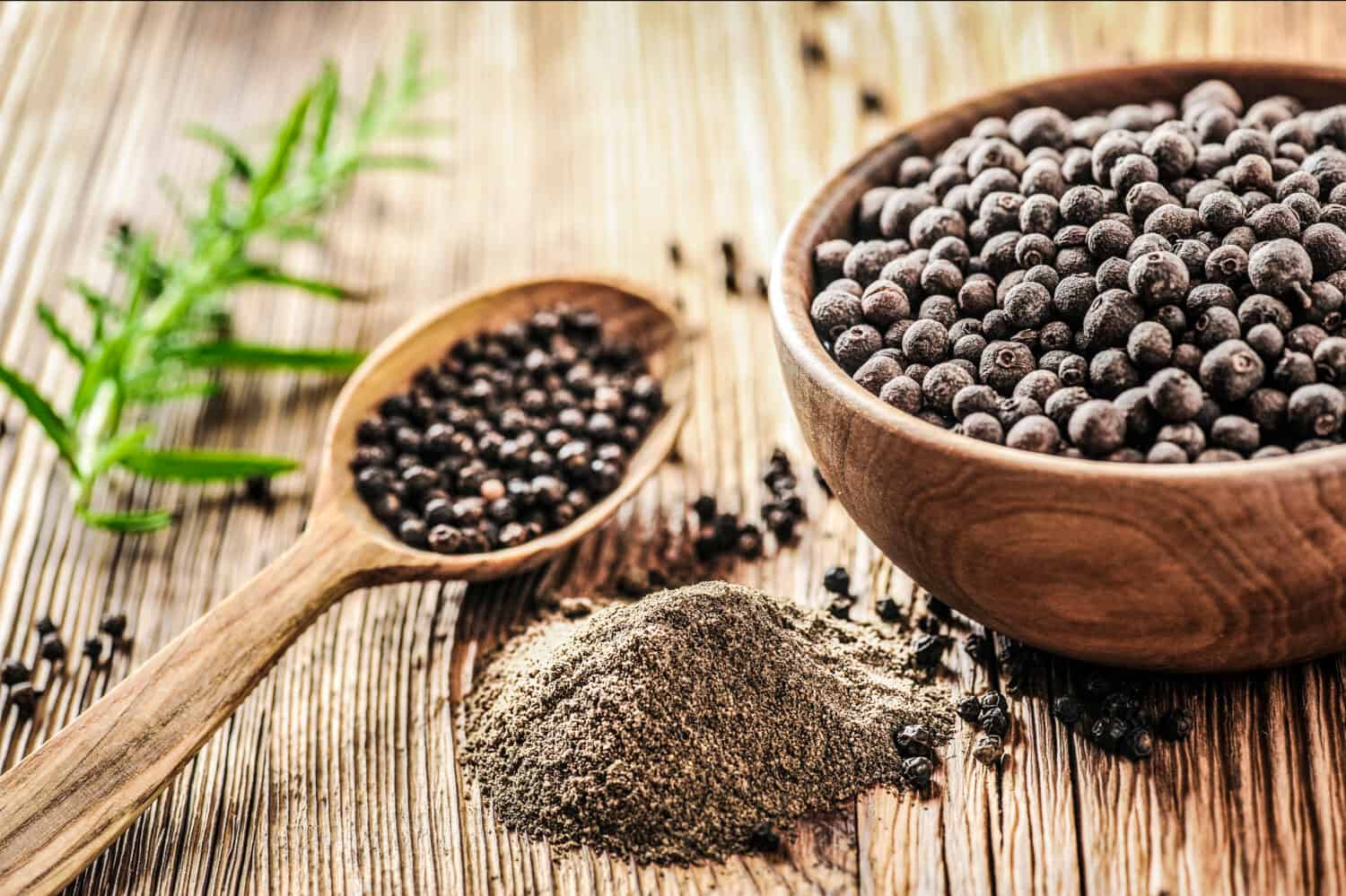How do you choose between black pepper and white pepper? Can you swap one pepper for the other? Native to India, black and white pepper is a popular spice throughout the world. Both peppers derive from a climbing plant named “piper negrum,” but their processing methods are different. After processing, black and white pepper develop distinct flavor profiles, leading to separate culinary uses for each pepper, although there is some overlap.
While neither spice offers many nutritional benefits, both peppers contain an antioxidant called piperine. Piperine may provide some health benefits, including aiding the body in reducing inflammation. We will examine the differences between black pepper and white pepper, consider their nutritional benefits, and recommend the best foods to pair with each spice.
Black Pepper vs. White Pepper: How are they different?
Pepper is one of the earliest known spices and has a long history of overland trading. Today, it grows in Indonesia and other tropical environments. The black pepper plant is sometimes as tall as thirty-three feet and has shiny, green leaves. Peppercorns, the fruit on the tree's vine, yield both kinds of pepper.
To make black pepper, farmers pick unripe peppercorns. After drying in the sun for up to four days, farmers grind the peppercorns. This results in a spicy, dark-colored pepper. However, white pepper undergoes a different process. Farmers cultivate peppercorns when they are ripe, soak them to ferment, then remove the outer layer of the peppercorn. Once the outer layer is gone, the inner, light-colored, and smooth peppercorn is ground up. This results in a paler pepper with a milder taste.
Black Pepper vs. White Pepper: Key differences
There are four key differences that separate black pepper and white pepper, including their appearances, tastes, health considerations, and cooking uses.
| Black Pepper | White Pepper | |
|---|---|---|
| Appearance | Dried, unripe berries give black pepper its darker appearance. | Made from ripe berries, white pepper is lighter because the outer shell of the peppercorn is removed before grinding. |
| Taste | It has a sharp and spicy taste that may have woody undertones. | White pepper is less spicy and has a less complex flavor overall. It lacks the earthy undertones of black pepper. |
| Health Considerations | Some believe black pepper is harder on the stomach, so take caution if you have a sensitive tummy. | Like black pepper, white pepper contains piperine, an antioxidant believed to have anti-inflammatory properties. |
| Uses in Cooking | Black pepper adds a kick to meat, vegetables, and condiments. It is a common ingredient in marinades and spice mixtures. | Sautéed and stir-fried meat benefits from white pepper. It is sometimes used because of aesthetic reasons. No black specks! |
Black Pepper vs. White Pepper: Which is more nutritious?
Both peppers contain very few calories and provide very little vitamins and nutrients. Furthermore, cooks don't use black or white pepper in large amounts. Their main purpose is flavoring. However, the piperine antioxidant in both peppers has been studied to discover potential health benefits.
Supposedly, piperine has anti-inflammatory properties. Like curcumin in turmeric, piperine may enhance the absorption of nutrients into the body's bloodstream. Researchers continue to conduct studies to investigate its potential role as a digestive aid. Additionally, piperine might promote good metabolic function. However, further research is necessary to confirm these potential health benefits.

©
Black Pepper vs. White Pepper: Best foods for each
Now that we know the differences between black and white pepper, what are the best foods for each? Here is a quick guide to the best food for each pepper.
Black Pepper
Black pepper is a key ingredient in marinades and meat rubs. Moreover, it is a popular preserve for meats. This pepper complements the richness of most meats, such as beef, pork, lamb, and chicken.
In addition to the most popular uses for black pepper, here are other foods to consider.
- Black pepper is especially good on vegetables like potatoes, carrots, and broccoli. Add to steamed or roasted vegetables to add flavor.
- This pepper adds depth to soups and stews like chili.
- However you enjoy your eggs, whether it's scrambled, fried, or hard-boiled, black pepper is a classic seasoning. Be sure to add it to your omelet, too.
- A pinch of black pepper can add a burst of flavor to salads. Additionally, black pepper is a common ingredient in salad dressing.
- Certain cheeses, like parmesan and aged cheddar, benefit from black pepper.
White Pepper
If you want a subtle spiciness with no visible specks of pepper, white pepper is the best choice. Light-colored meats like chicken, turkey, and pork are perfect because the white pepper will not overpower the dish. Here is a list of other foods that taste better with white pepper.
- Certain creamy soups, like potato and mushroom soups, benefit from white pepper. It also blends into sauces like alfredo very well.
- White pepper is a common spice in Asian cuisine, particularly Chinese and Thai dishes.
- Grain-based dishes like risotto combine well with white pepper.
- Baked goods, including rolls, biscuits, and quiches, are excellent with a bit of added white pepper.
- Add white pepper to dips and dressing for a subtle heat that doesn't overwhelm the flavor.
When using white pepper, start with small amounts and adjust for taste. This will prevent the pepper from overwhelming the dish.
In Summary
Black and white pepper are two of the most popular spices in the world. Both are harvested from the “piper negrum” plant but undergo different processes. Farmers harvest black pepper before the berries are ripe, then dry them to give the pepper its distinctive look and smell. On the other hand, farmers soak ripe berries and then remove their outer shells to create white pepper. The result is a paler pepper with a more neutral taste and spiciness. Both peppers have very little nutritional value. Their main purpose is to enhance dishes. Each pepper pairs well with certain foods. For instance, black pepper is an excellent choice for marinades, whereas white pepper enhances creamy soups like potato. With each pepper, start off with small amounts and adjust according to your taste preferences.

You may think that black pepper and white pepper are the same, but they serve different purposes. Let's reflect on this article about what those differences are:
- While both black pepper and white pepper are used on meat, black pepper is common in marinades, while white pepper is great in stir-fried recipes.
- The most common difference is the appearance: black pepper is darker, and white pepper is lighter.
- White pepper has a milder, less spicy flavor, whereas black pepper has a spicier taste.

Braised Chicken with Asparagus, White Wine, and Black Pepper
- Total Time: 25 minutes
Ingredients
- 1 tablespoon olive oil
- 1 1/4 pounds boneless, skinless chicken breasts, cut into 2-inch pieces
- 1 tablespoon lemon and herb seasoning
- 1/2 cup dry white wine or vermouth
- 1 cup reduced-sodium chicken broth
- 1 bunch asparagus, stem ends trimmed and spears cut into 2-inch pieces
- Salt and fresh ground black pepper for taste
Instructions
- Heat the oil in a large skillet over medium-high heat.
- Add the chicken and cook for 2 to 3 minutes until golden brown on all sides, stirring frequently.
- Add the seasoning and cook for 1 minute until seasoning is fragrant.
- Add the wine and cook for 1 minute.
- Add the broth and asparagus and bring to a simmer.
- Simmer for 3 to 5 minutes until the chicken is cooked through, and the asparagus is crisp-tender.
- Season to taste with salt and freshly ground black pepper before serving.
- Prep Time: 10 minutes
- Cook Time: 15 minutes
- Category: Main Course
- Method: Braising
- Cuisine: American
The image featured at the top of this post is ©Krasula/Shutterstock.com.


